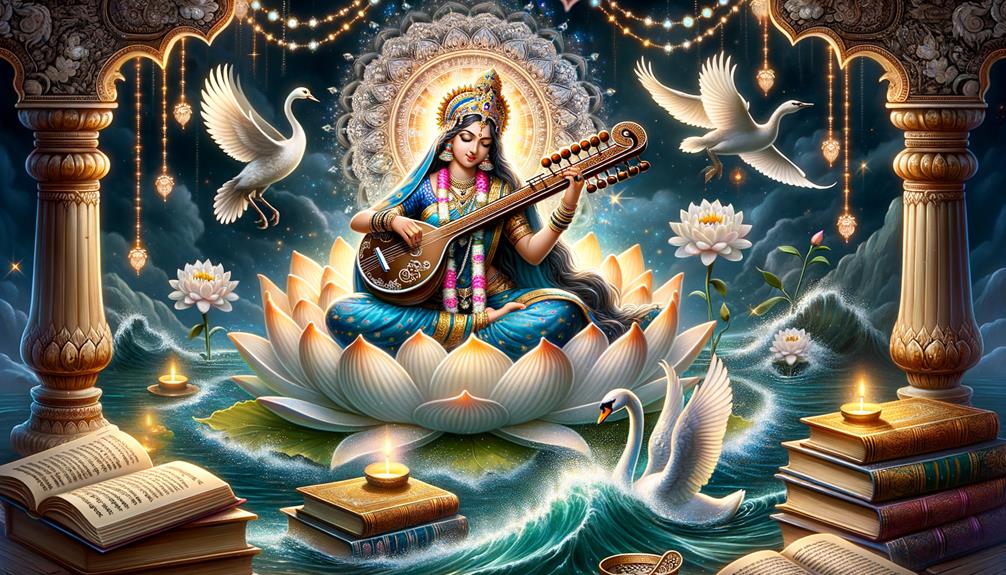Let’s dive into the captivating world of Parvati, the Hindu goddess known for her kindness and motherly love. She’s not just a symbol of compassion, but a divine figure with multiple facets to her character.
She’s often portrayed as the embodiment of deep affection and understanding, qualities that go beyond simple emotional sentiment. Parvati represents a deep spiritual wisdom that’s deeply ingrained in Hindu philosophy.
It’s an incredible thing to see how her stories weave together kindness with strength, underlining her crucial part in the grand scheme of the universe. But as we dig deeper into her tales and legends, a question arises – is Parvati’s kindness just a gender-based trait, or is it a representation of a more comprehensive, universal principle that goes beyond gender and individual roles?
To understand this, we need to pay close attention to Parvati’s symbolism, mythology, and the effect she has on culture. This promises to be a journey of illuminating revelation.
Understanding Parvati’s Origins

Let’s take a quick journey to explore where Parvati, a key Hindu deity, comes from. Known by many names, including Uma, Parvati is strongly associated with mountains. This connection is clear in her name Uma, which is drawn from the Sanskrit word ‘parvata’ meaning mountain. This is fitting, considering she’s the daughter of King Himavan. She also goes by other names linked to mountains, like Shailaja, Adrija, and Nagaja.
But there’s more to Parvati than just mountains. As one of the primary gods in Hinduism, she’s seen as a living embodiment of Shakti, a powerful feminine energy. This aspect of her character connects her to other goddesses such as Lalita Tripurasundari, Kamakshi, Annapurna, and Mahakali, showcasing the versatility and complexity of her identity.
Digging into ancient texts, you can see that Parvati’s presence is quite fascinating. Though her name doesn’t show up directly in Vedic literature, she’s mentioned as Uma-Haimavati in the Kena Upanishad. As we explore further in Kalidasa’s plays and the Puranas, we can see her character and symbolism growing richer and deeper, intertwining with goddesses Uma, Haimavati, Ambika, Kali, Gauri, and Nirriti.
In the context of Hinduism, Parvati plays a vital role. As the mother goddess, she’s a symbol of the divine energy that exists between a man and a woman, similar to the energy between Shiva and Shakti. Her story is an essential thread in the intricate design of the Hindu pantheon, opening up a world of interpretation and understanding.
Parvati’s Iconography and Symbolism
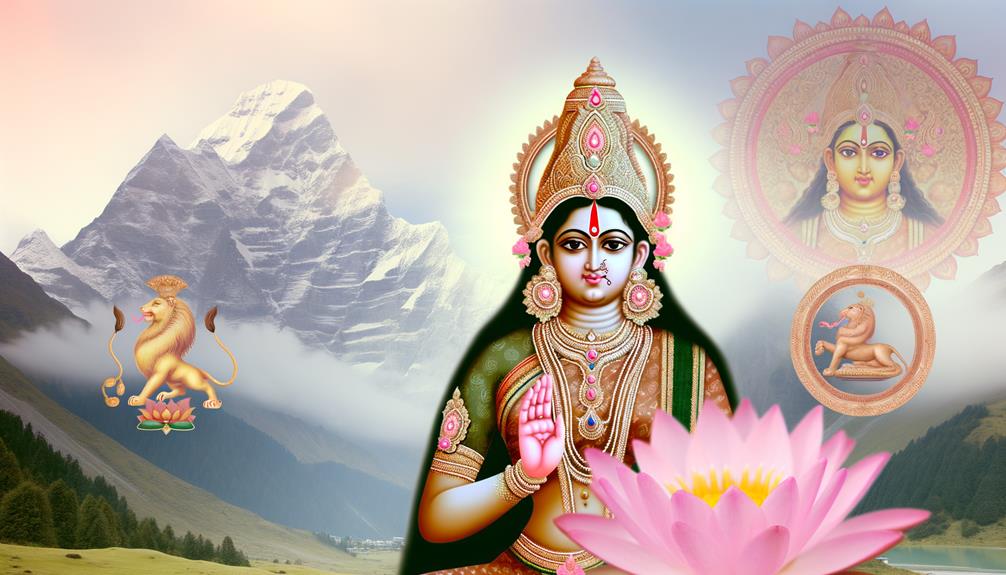
When we consider the iconography and symbolism of Parvati, we’re instantly drawn to her usual representation as a striking, beautiful and kind figure, often dressed in red and adorned with a headband. Goddess Parvati is commonly shown with two arms when with Lord Shiva, but she might possess four when she’s alone. The objects in her hands can vary, each one telling a story about her many qualities.
The marriage of Parvati and Shiva isn’t just a union, it’s a demonstration of the perfect harmony between male and female energies. Commonly, the iconography of Parvati includes the Linga-yoni, a symbol of this special union. The different mudras expressed by Parvati’s hands also help to tell the tale of her divinity.
Devotees of Parvati value her in all her forms and moods. She’s represented by a parrot, a crescent moon, and at times, she assumes the fierce persona of Kali when the situation calls for it. These symbols add a layer of complexity to Parvati’s iconography and symbolism, offering a deeper understanding of her character and her central role in the Hindu faith.
Parvati, as a mother goddess, is the embodiment of compassion, power, and the perfect harmony of energies.
The Many Manifestations of Parvati
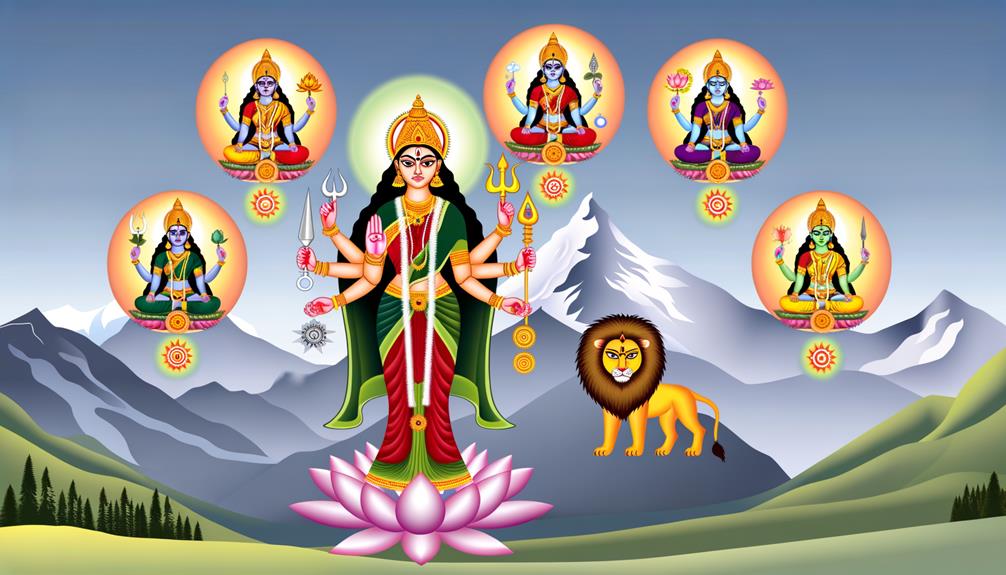
Let’s chat about Parvati, a major goddess in Hindu mythology, known for her many different forms. She isn’t simply a caring mother. She’s also a formidable warrior, a loving spouse, and a representation of divine energy.
Let’s delve into four of her most important forms:
- Parvati as Durga: In a meeting with other Hindu gods, Parvati turned into Durga, a goddess with ten arms and a warrior’s spirit. As Durga, she often fights demons, representing the struggle against ignorance and evil.
- Parvati as Kali: Parvati’s most fearsome form is Kali, the destroyer of evil. Despite her scary image, she’s also viewed as a protective mother.
- Parvati as Sati: Before she became Parvati, she was Sati, Shiva’s first wife. Her sacrifice out of love exemplifies devotion and loyalty.
- Parvati as Gauri: In her Gauri form, Parvati’s softer side shines through. She represents purity and austerity and is often linked with fertility and happy marriages.
Each form gives us a unique insight into Parvati’s complexity as a Hindu goddess. They all highlight her many-sided nature, showing the many ways she represents divine femininity and power.
Parvati’s Influence on Culture
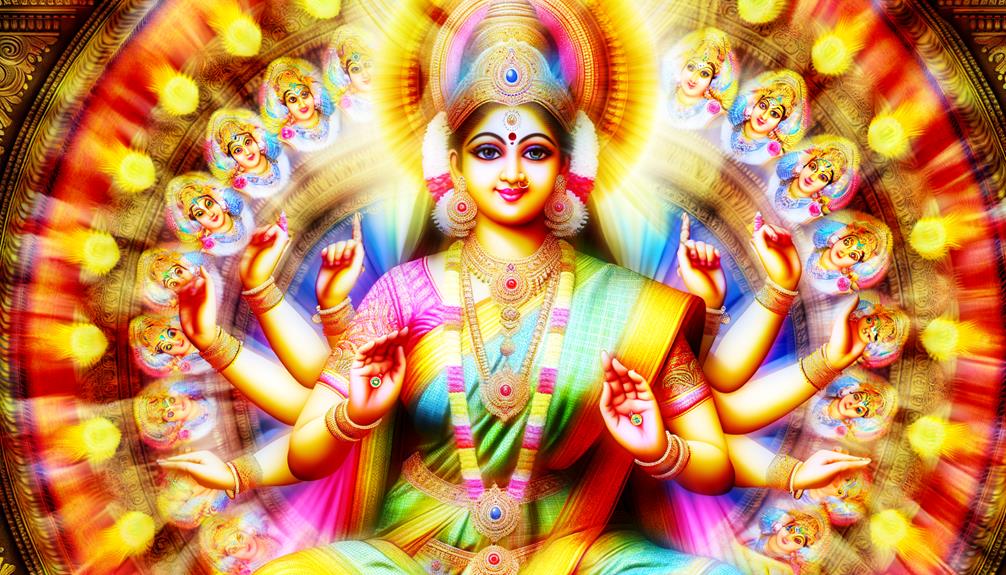
Parvati, with her varied forms and roles, has a substantial influence on multiple facets of Hindu culture, from the language we use to the art we create. This influence shapes how we think about goddesses and helps to instill societal values like compassion and the importance of family.
If you’ve seen South Indian temples, you’ve likely noticed Parvati’s iconography. It showcases her cultural importance, especially as Shiva’s wife and the universal mother in Hindu mythology.
Let’s chat more about her impact. Parvati is a figure of worship in many Indian states. Her stories and legends are at the heart of many local variations of Hinduism. Parvati, as a mother and a wife, stands as an ideal. The stories about her emphasize the importance of compassion and family unity. Her names, derived from Sanskrit and reflecting her many attributes, have a deep connection to Hindu literature and have enriched the language of the culture.
Temples Dedicated to Parvati
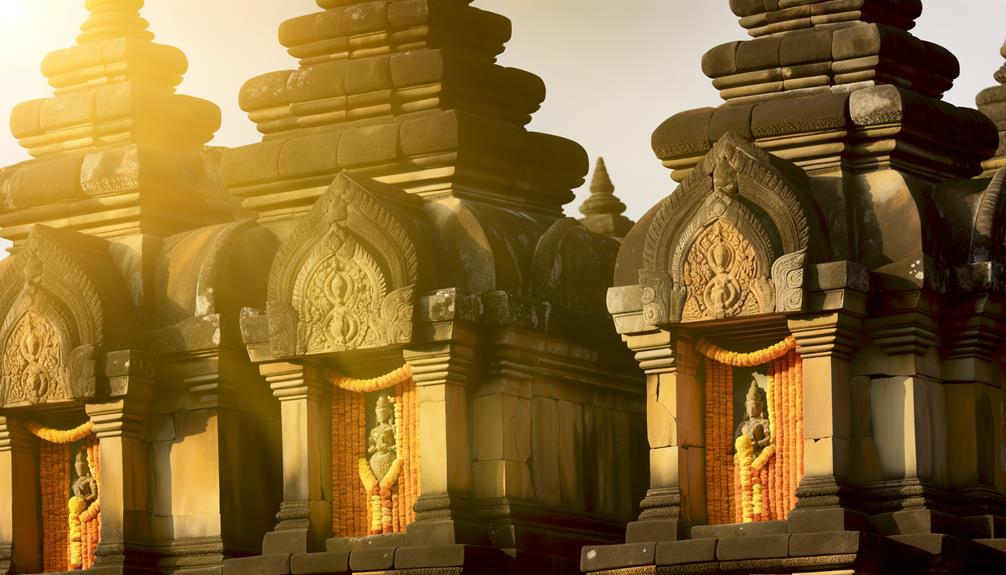
All over Southern and Southeastern Asia, there’s a wide array of temples that honor the caring mother goddess, Parvati. Her divine influence and symbolic significance have greatly impacted Hindu mythology and religious customs.
- Take, for instance, the Kailasa Temple in the Ellora Caves. It’s perhaps the most recognized temple dedicated to Parvati. This remarkable structure often depicts Parvati with her partner, Shiva, reflecting the interconnected nature of their divine powers.
- Parvati is also revered as Kali Ma, the intimidating, omnipresent goddess, in numerous temples scattered across Southeast Asia. Her portrayals as Kali, typically with a tongue sticking out and a third eye, signify her ability to overcome ignorance and deception.
- There are temples that celebrate Parvati as the goddess of love and highlight her nurturing and motherly qualities. Her kindness reaches all creatures, instilling in worshippers a desire to develop the same trait in their personal lives.
- The sight of Parvati near a calf or a cow in ancient temples signifies her role as a universal mother, caring for and safeguarding all living beings.
Frequently Asked Questions
Is Parvati the Mother Goddess?
Absolutely, Parvati holds the title of the Mother Goddess within the tales of Hindu mythology. She’s the embodiment of divine feminine power and compassion. Notably, she stars in significant roles as the spouse of Lord Shiva and the parent to Ganesha and Kartikeya.
What Does the Goddess Parvati Represent?
As someone who worships her, I see Parvati as the embodiment of divine femininity. She signifies kindness, tender care, and resilience. Many know her as Shiva’s partner and Ganesha’s mom, a clear sign of her dedication to family. It’s her love and loyalty that encourages us to bring more compassion into our daily routines.
Who Is the Goddess of Motherly Love in Hinduism?
Have you ever wondered about the deity representing motherly affection in Hindu beliefs? Well, that honor is held by Parvati. As the goddess of motherly love, she is a symbol of devotion, affection, and care – all the crucial aspects that define motherhood. People admire her divine character that beautifully mirrors the essence of motherhood.
How to Please Goddess Parvati?
If you’re wondering how to win the favour of Goddess Parvati, it’s pretty straightforward. Make sure you’re living a good and decent life. Commit to a routine of regular prayers and make offerings like fruits or flowers. She values sincere devotion, so remembering her daily is a big part of it as well. It’s about keeping her in mind and in your heart throughout your everyday activities.
Conclusion
Parvati’s story ultimately tells us about the power of compassion to change things. She’s not only seen as a mother goddess, but also as an emblem of the strength of empathy, nudging us all to be kinder to those outside our immediate connections. Through her, we get a gentle nudge to view suffering as a shared experience, fostering a more empathetic viewpoint.
With her essence seeping into our culture and sacred spaces, it highlights the timeless importance and life-altering potential of compassion.

